05
CRYOPEN ®
The Worlds No.1 Benign Skin Lesion Removal Device.
Cryopen is an innovative, high-performance cryosurgery tool to safely remove unsightly skin tags, warts, age spots and other benign skin lesions.
The CryoPen ® allows professionals to work with millimetre precision for removing all benign skin lesions with no more collateral damage to healthy tissue.
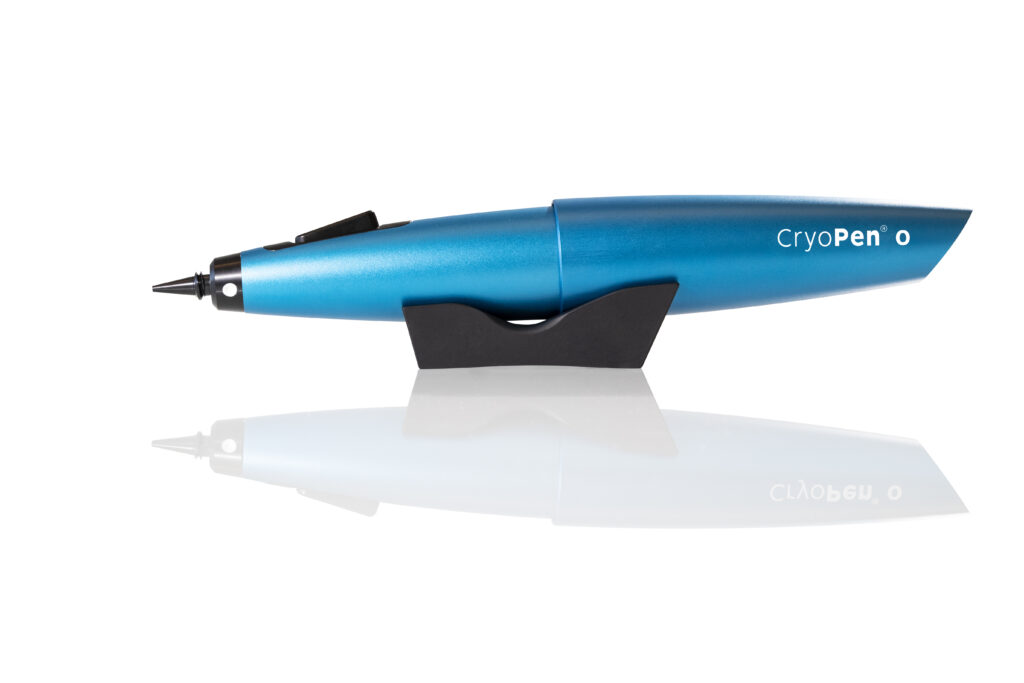
Bennefits of CryoPen
- Versatile treatment options, treats lesions from 1mm to 10mm in size
- Fast treatments, treats a 2mm lesion in 10 seconds
- Safely treats lesions on face and close to eyes
- Pinpoint accuracy, treats just the lesion and not healthy surrounding tissue, no follow up care needed
- Minimal discomfort to patient
- Doesn’t touch skin (no messy buds, cones or apertures)
- Enhanced accuracy
WARTS
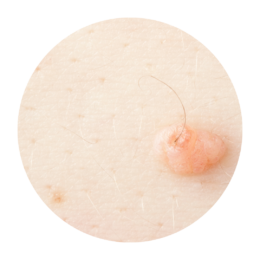
Warts
Common warts are small, rough, hard, nodular lumps on the skin that most people have at some point in their life.
They often develop on the skin of the hands and feet, but they can be found anywhere.
Warts vary in appearance and may develop singly, however; they are more commonly found in clusters.
Warts are caused by an infection with the human papilloma virus (HPV) and whilst they are not harmful, they are contagious.
TREATMENT
During the treatment a mild white frost should form evenly over the lesion. Following an initial freeze, the tissue should be allowed to thaw for about 30 seconds followed by a second freeze.
After thawing, the tissue turns red-ish coloured and has the aspect of a zone of inflammation due to interstitial bleeding. Warts typically disappear 14 days following treatment. Aggressive Plantar’s or mosaic warts may require a follow-up treatment after the initial procedure.
It is advised to do 3 sessions, each a week apart. The treated area should then be given 2 weeks to heal and hopefully clear up. If the area has not fully cleared, another 3 sessions may be required to see results.
AGE SPOTS
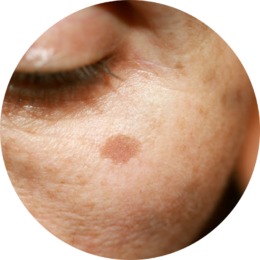
SUN SPOTS
What are they?
Lentigines (Age Spots) are harmless flat brown lesions which do not darken following sun exposure.
They can vary in size from 5-20 mm and well-circumscribed patches can be round, oval or irregular in shape.
They occur over the shoulders in young people, more common among those who have had more sun exposure and in the elderly on the sun exposed sites such as the dorsum of the hands and forearms, the face and the neck.
Causes
They are caused by exposure to ultraviolet (UV) radiation, which causes accumulation of melanin within the skin cells.
They are very common, especially in people over the age of 40 years. They are also known as an “old age spot” or “senile freckle”.
Treatment with CryoPen
During the treatment, a mild white frost should form evenly over the lesion followed by a shiny effect. Your lesion will be darkening immediately following treatment.
After the treatment, the tissue turns red-ish coloured and may have a zone of inflammation due to interstitial bleeding.
Lentigines typically disappear 10-14 days following
treatment.
SKIN TAGS
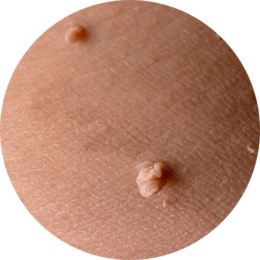
SKIN TAGS
What are they?
Skin tags are small growths that hang off of your skin, they are very common and harmless.
They are commonly found on the neck, axilla region, under the bra area and in the groin. They can also grow on the eyelids or under the folds of the buttocks. These are small, soft, skin-coloured growths on your skin.
They appear in various colours, from flesh to dark brown, and from a few millimetres up to 5cm wide.
They may be just slightly raised, or they will have a stalk or neck like a mushroom, or they might have a flat neck.
Causes
Both men and women can develop skin tags, but they are more common in older people, people with type 2 diabetes or obese people.
They are made of loose collagen fibres and blood vessels surrounded by skin.
People who develop several skin tags may have a genetic predisposition as this condition often runs in families.
Friction is also another contributing factor as they appear in the areas where clothes may rub, such as collar lines, bra straps, underarms and groin etc.
Treatment with CryoPen
During the treatment, a mild white frost should forms evenly over the lesion. A successful endpoint is indicated by a mild, white raised blister covering the entire lesion.
Immediately after the treatment, the tissue turns red-ish coloured and may have a of zone inflammation due to interstitial bleeding. Skin tags have typically disappeared within 14 days of treatment.
You will see an immediate improvement of the skin tag, then it will be allowed some time to heal and shows considerable improvements over time.
VERRUCAS
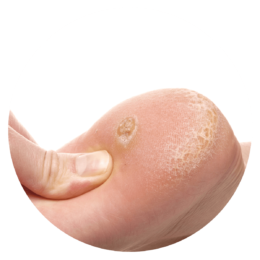
VERRUCAS
What are they?
Verrucas are warts that usually grow on the soles of the feet. They are a viral skin infection that appears on the outermost layer of the skin.
The affected area of skin will be white, often with a black dot (blood vessel) in the centre; be flat rather than raised; it can often be even painful if they are on a weight bearing part of the foot.
Causes
Similarly to common warts, verrucas are contagious.
They can quickly spread from person to person by contact with contaminated objects.
After you become infected, it can take weeks or even months for a verruca to appear.
The possibility of catching a verruca increase when your skin is wet, damaged or you have a weak immune system.
Treatment with CryoPen
During the treatment, a mild white frost should form evenly over the lesion. Following an initial freeze, the tissue should be allowed to thaw for about 30 seconds followed by a second freeze.
After thawing, the tissue turns red-ish coloured and has the aspect of a zone of inflammation due to interstitial bleeding. Verucas are typically removed 14 days following treatment.
Aggressive Plantar’s or mosaic warts may require a follow-up treatment after the initial procedure.
It is advised to do 3 sessions, each a week apart. The area should then be given 2 weeks to heal and hopefully clear up. If the area has not fully cleared, another 3 sessions may be required to see a result.
Pre Treatment Advice: Viral lesions are the hardest to treat because you are treating the lesion as well as the virus. In the days leading up to the appointment, your practitioner may recommend to do a pre-treatment to the wart or verrucae to prepare it for the best possible treatment.
CHERRY ANGIOMAS
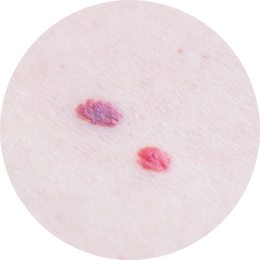
CHERRY ANGIOMAS
What are they?
Cherry Angiomas or (haemangiomata) is the name of a benign or non-cancerous overgrowth of blood vessels in the skin. They do not fade with pressure.
Angiomas in adults include cherry angiomas or more commonly known as blood sport or Campbell de Morgan spots, and they may be found on any part of the body. More commonly, they can be found mid-torso. It appears as red to purple papules or plaques with a normal epithelial surface, occurs on the abdomen and chest. They generally increase in number from the age of 40.
Causes
Haemangiomata are most likely caused by the proliferation of endothelial cells that line the blood vessels, and whilst the exact cause is still unknown, it seems to be part of the natural aging process. There may also be a genetic factor that makes certain people more likely to get them.
Whatever the reason for inheriting this skin lesion, Cryosurgery with CryoPen is the safest and fastest solution on the market that is medically backed industry wide.
Treatment with CryoPen
During the treatment, a mild white frost should form evenly over the lesion. A successful endpoint is indicated by a mild, white raised blister covering the entire lesion.
Immediately after the treatment, the tissue turns red-ish coloured and has the aspect of a zone of inflammation due to interstitial bleeding. Cherry angiomas typically is removed 14 days following the treatment.
MILIA
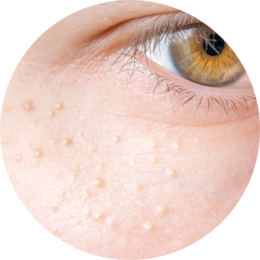
MILIA
What are they?
Milia are very small, raised, pearly-white or yellowish bumps on the skin, each are usually about 1 or 2 millimetres. It is a type of tiny skin cyst filled with a protein called keratin. They are most often seen on the skin around the cheeks, nose, eyes and eyelids, forehead and chest.
They are commonly found in areas of dry skin where normal secretions are unable to find their way to the skin’s surface. It they are located on areas on the skin that is not dry, they maybe be caused by poor product usage.
Causes
Milia are typically associated with some type of damage to the skin such as blister, burn or sun damage. It can also delevop if the skin loses its natural ability to exfoliate. It can happen as a result of ageing.
Treatment with CryoPen
During the treatment, a mild white frost should form evenly over the lesion. After thawing the tissue turns red-ish coloured and has the aspect of a zone of inflammation due to interstitial bleeding.
Be sure to speak to one of our experts if you have any questions on how this treatment works.
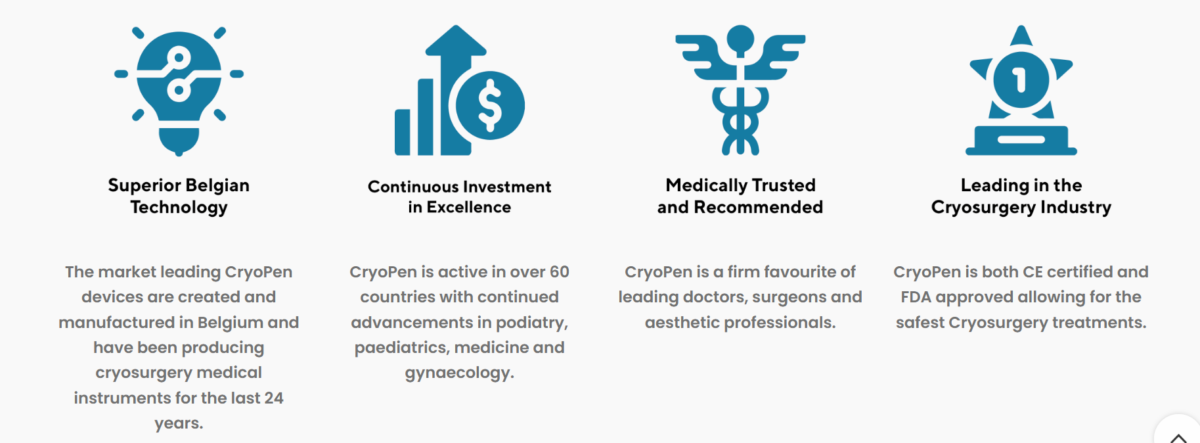
FAQ
Frequently Asked Q's
How does it work?
The treatment works by delivering an intensely cooled jet of high pressure nitrous oxide directly on the skin tag. The nitrous oxide destroys the skin tissue by causing the water in the targeted cells to freeze and expand, which breaks the cell membrane and causes the unwanted skin tissue to die.
Is it safe?
CryoPen treatment is considered safe when carried out by a qualified professional, with a minimal risk of scarring when compared to other forms of surgical removal. The treatment is very precise and does not contain liquids or gases, so there is a reduced risk of damaging the surrounding tissues. It is considered safe enough to use on children.
is the treatment painful?
The treatment is considered to be virtually painless, although some patients might feel a mild discomfort such as a slight stinging or prickling sensation. The effects of this can be lessened with a cooling device. It is a very quick treatment with no downtime and simple aftercare.
Follow the aftercare instructions carefully, such as keeping the area clean and protected from strong sunlight or abrasive materials.